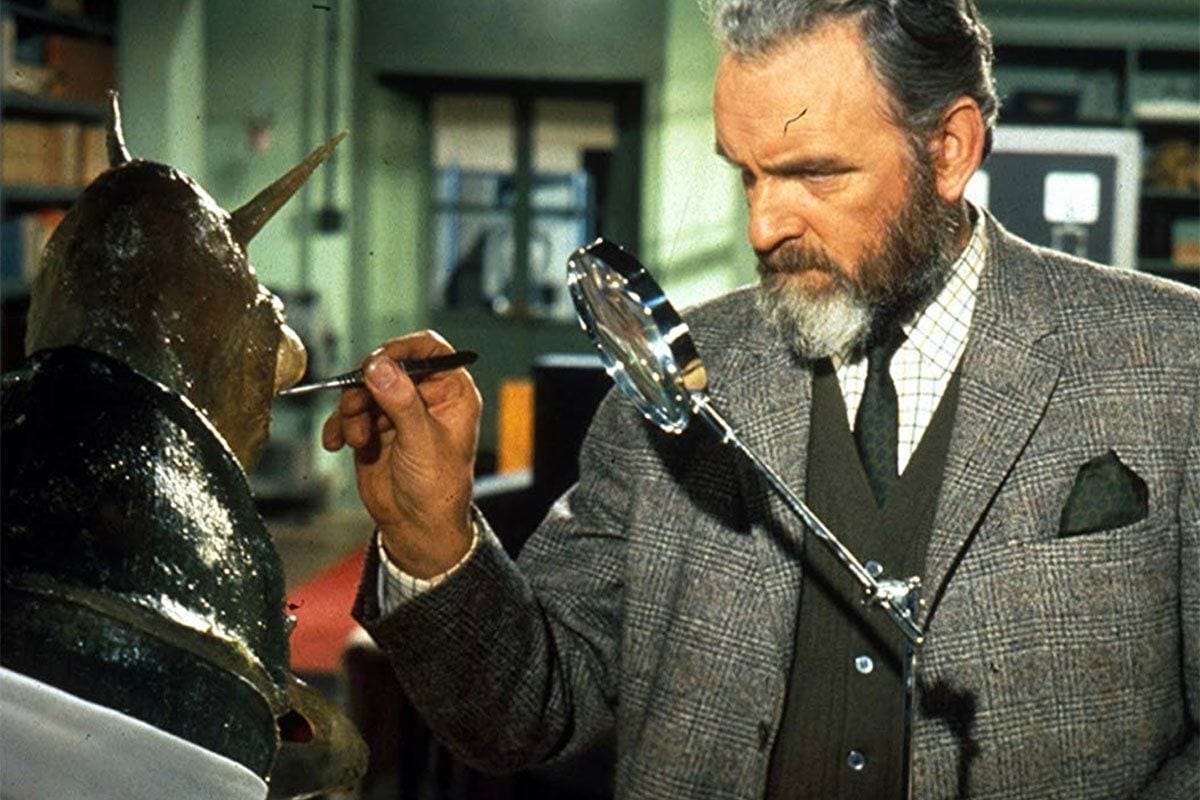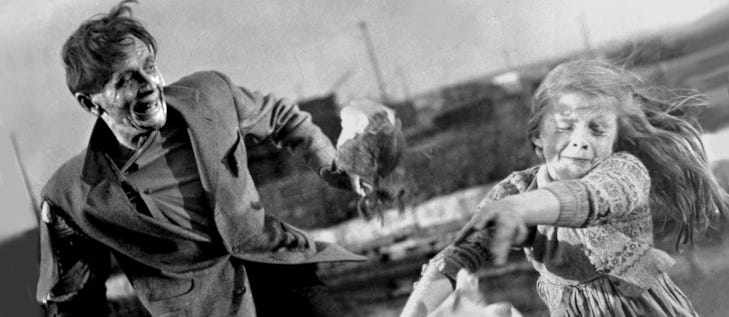As a way of getting my figurative ya-yas out, I embark on a series I’m calling Deep Dive. This occasional tangent will take a literal extensive analysis and / or history of a thing that deeply interests me. So you can either groove on or move on. I mean, I can’t just complain about being over 50 every week. Even I am tired of that!
Also just a note at the top that you all make this possible with your kind subs and donations. Anything helps keep the wheels on!
There are certain ur-texts that drive whole swaths of genre media.
HP Lovecraft’s Cthulhu mythos is one. The Universal Pictures universe of Dracula, Frankenstein, the Wolf Man and the Invisible Man. The vampiress Carmilla. For a while in the swinging 70s, de Sade was heavy in the genre zeitgeist.
In science fiction, it’s Godzilla, and the Body Snatchers, Carpenter’s take on The Thing, Philip K Dick’s work. William Gibson’s cyberpunk.
For me, it’s always been the Quatermass series.
There are those moments or memories that have had recurring and consistent impact and influence on everything I do creatively. Sam Raimi’s Evil Dead movies is one, Romero’s Night of the Living Dead another. Jean Renoir’s La Grande Illusion, the Marx Brothers’ Duck Soup, Howard Hawks’ His Girl Friday, Mamet’s (and James Foley’s) Glengarry Glen Ross, John Sayles’ City of Hope and Passion Fish – these are all movies that in some way shaped me.
But the grandaddy of them all for me has been the British Quatermass series.
Created by Nigel Kneale, the impact of that quintessentially British science fiction series – originally several television serials, then later movies, mini series, live adaptations, books and radio dramas, has been keenly felt in mainstream media from Doctor Who to the X-Files. It’s the basis for John Carpenter’s obsessions. It was the first horror series Hammer Studios produced.
In essence, it’s one of the most important franchises in horror history. And it’s pretty much ignored by the contemporary genre mainstream.
There’s a peculiarly British word, “Boffin.” That’s what Bernard Quatermass is. A scientist engaged in astronomical research. With visions beyond close orbit. Visions that challenge the humdrum bureaucrats around him.
Rocket scientist, boffin, staunch anti-bureaucrat Bernard Quatermass is essayed by different actors almost every time.
In the first couple films he is belligerent and obstreperous American actor Brian Donlevy, apparently drunk the entire time. This would be the only time the same actor played Quatermass in more than one standalone story.
In Quatermass and the Pit — arguably the best of the series, and the most accessible — he’s the less coarse yet still rigidly scientific Scotsman Andrew Keir.
In the Conclusion, Sir John Mills authors a more avuncular take as the world spirals into further distress.
In the BBC serials, Reginald Tate, André Morell and John Robinson take turns.
League of Extraordinary Gentlemen and X-Men actor Jason Flemyng updates the role but doesn’t further define it in the live BBC Channel Four experiment – which is where David Tennant, playing yet another scientist, would be offered the role of Doctor Who, in rehearsals.
Quatermass was a sort of science fiction Hamlet, everyone wanted a shot at playing him.
Like Doctor Who, played by a multitude of personae over the years, the actor is a mortal mirror to reflect against the supernatural goings on, whether they be 50 million year old Martians or tanks of man-eating goo.
In the nascent BBC serials, which it took me years to find, to the Hammer films, which I saw first, through to the Channel 4 live broadcast of the Quatermass Experiment with Jason Flemyng, David Tennant and Mark Gatiss, the series ticked neat boxes for me in my evolving cultural tastes.
Determined if stoic British pacing, damn fine writing, monsters, technobabble, grounded seriousness, demonic plights – the series has it all.
Contemporary themes recur in various strata of Quatermass subtext: the thin line between society and chaos, the paranoia of the Cold War, bureaucracy blocking progress, the danger of that same progress, technology over man. Shades of AI panic.
Quatermass’ influence was not only felt in Doctor Who and the X Files, director John Carpenter asked creator Kneale to write the script for Halloween III, the non-Michael Myers entry. Although that collaboration ended in squabbles, Carpenter would later use the pseudonym Martin Quatermass scripting his very Quatermass and the Pit-inspired Prince of Darkness.
In each, a vessel is unearthed in a public place and carries with it echoes of a different time and place with malevolent and supernatural intent, not to mention the freakin’ devil.
The blog Cinematic Wicker Man refers to Quatermass as belonging to a branch of Folk Horror called Urban Wyrd. (Spelling is definitively not mine)
Urban Wyrd represents the demonic darkness lurking under the surfaces of city life, from the zombies in the metro subway in Raw Meat (Death Line in the UK) to mutant reptiles in the sewers in Lewis Teague and Sayles’ Alligator.
I find this sort of genre hokum fairly silly. But Quatermass exists across sub-genres, ripe for picking.
James Bernard’s Hammer Film scores had a way of using music to sound out character and title names. Like the three note sting in Dracula (1958) pronouncing “Drac-U-Laaa.” Here you can hear him straining to get out the syllables of Qua-ter-mass And The Pit!”
Cracks me up every time.
Quatermass creator Kneale also wrote several key British science fiction series and standalone films, including The Stone Tape, a beautifully written, though hampered by era-specific technical limitations, teleplay about ghostly energies stored in brickwork.
His series Beasts has six stories of bestial horror. And few who have seen it have forgotten his adaptation of The Woman in Black, recently remade into a film with Daniel Radcliffe.
Kneale also wrote the screenplay for the original adaptation of John Osborne’s kitchen sink drama Look Back in Anger.
Kneale’s work — richly grounded in reality while still devoted to the fantastical — influenced The X Files probably as much as did Kolchak The Night Stalker.
The entirety of Kneale’s work, along with, of course, Quatermass himself, is ripe for rediscovery.
A24, are you listening?
This is Are You Experienced. I’m Nick Tangborn and this is a weekly newsletter about things I find interesting, quite often about aging and career and digital media and food and comics and horror movies and indie rock and, well, just about anything else.









A TANGBORN tangent!
Funnily enough, the little girl in the picture you pulled from The Quatermass Xperiment is Jane Asher, who later starred in The Stone Tape. Kneale is brilliant...After I tracked down a copy of the 1979 mini-series, The Fall's "Lay of the Land" made a lot more sense